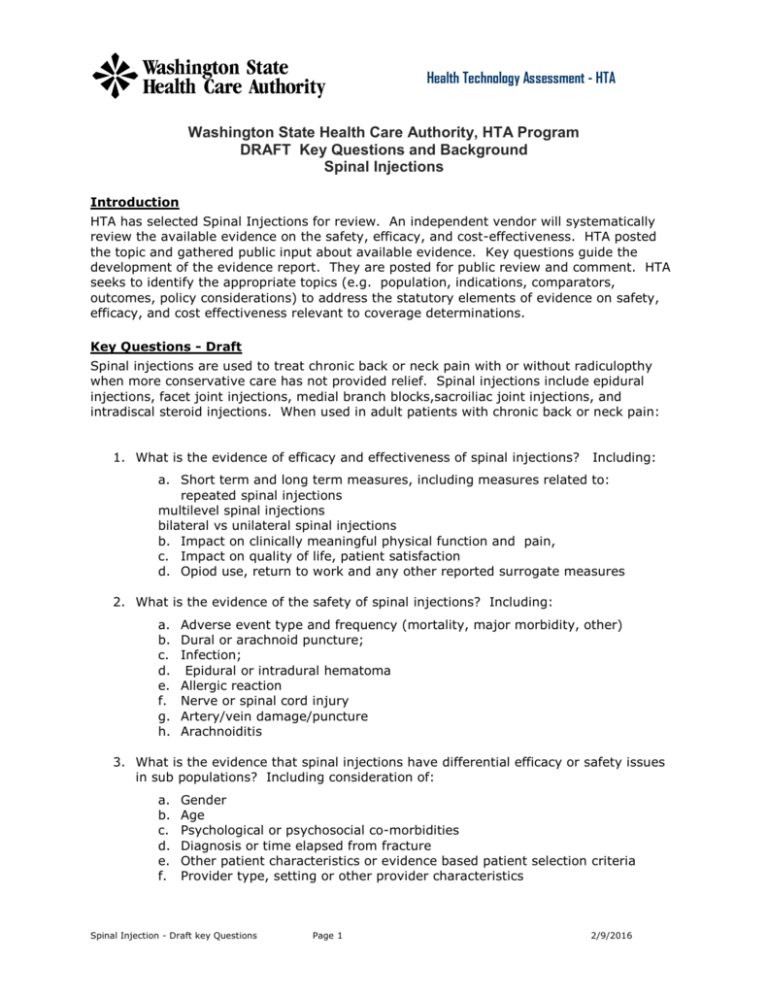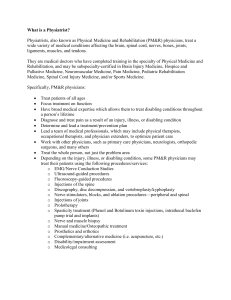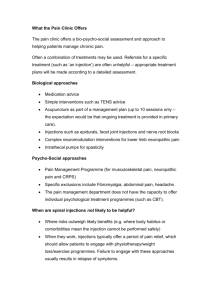Washington State Health Care Authority, HTA Program
advertisement

Health Technology Assessment - HTA Washington State Health Care Authority, HTA Program DRAFT Key Questions and Background Spinal Injections Introduction HTA has selected Spinal Injections for review. An independent vendor will systematically review the available evidence on the safety, efficacy, and cost-effectiveness. HTA posted the topic and gathered public input about available evidence. Key questions guide the development of the evidence report. They are posted for public review and comment. HTA seeks to identify the appropriate topics (e.g. population, indications, comparators, outcomes, policy considerations) to address the statutory elements of evidence on safety, efficacy, and cost effectiveness relevant to coverage determinations. Key Questions - Draft Spinal injections are used to treat chronic back or neck pain with or without radiculopthy when more conservative care has not provided relief. Spinal injections include epidural injections, facet joint injections, medial branch blocks,sacroiliac joint injections, and intradiscal steroid injections. When used in adult patients with chronic back or neck pain: 1. What is the evidence of efficacy and effectiveness of spinal injections? Including: a. Short term and long term measures, including measures related to: repeated spinal injections multilevel spinal injections bilateral vs unilateral spinal injections b. Impact on clinically meaningful physical function and pain, c. Impact on quality of life, patient satisfaction d. Opiod use, return to work and any other reported surrogate measures 2. What is the evidence of the safety of spinal injections? Including: a. b. c. d. e. f. g. h. Adverse event type and frequency (mortality, major morbidity, other) Dural or arachnoid puncture; Infection; Epidural or intradural hematoma Allergic reaction Nerve or spinal cord injury Artery/vein damage/puncture Arachnoiditis 3. What is the evidence that spinal injections have differential efficacy or safety issues in sub populations? Including consideration of: a. b. c. d. e. f. Gender Age Psychological or psychosocial co-morbidities Diagnosis or time elapsed from fracture Other patient characteristics or evidence based patient selection criteria Provider type, setting or other provider characteristics Spinal Injection - Draft key Questions Page 1 2/9/2016 Health Technology Assessment - HTA g. Payor/ beneficiary type: including worker’s compensation, Medicaid, state employees 4. What evidence of cost implications and cost-effectiveness of spinal injections? Including: a. Direct costs over short term and over expected duration of effect b. Comparative costs Technology Background Disease: Back and neck pain are common conditions, with sixty to eighty percent of U.S. adults afflicted at some time during their life. Back pain, and then neck pain, are the most common causes of disability and loss of productivity. Approximately 90% of low back pain is of the nonspecific type, and a similar majority of neck pain is non-specific. Most patients’ symptoms resolve satisfactorily within a relatively short time span (within six weeks). In 5 – 10% of patients, pain does not satisfactorily resolve and the symptoms can be disabling and the social and economic impact of chronic pain is enormous. Discovering the cause for nonspecific low back and neck pain symptoms remains challenging. Some psychosocial risk factors for the progression to chronicity have been identified, but the origin and neurophysiologic pain sensations are poorly understood. Treatments: Chronic pain treatment may include pharmacological treatment, physical therapy, psychological care and coping skills, exercise, education, antidepressants, cognitive behavioral therapy and supported self-management, spinal manipulations, electrical stimulation, injections, implanted devices, and other surgical treatment. Treatment strategies generally begin with the least invasive and low risk interventions and progress if the treatments are not effective. Treatment often involves a combination of interventions. Technology: Spinal injections are usually performed after appropriate non-surgical treatments have been given a fair trial and have not provided adequate relief. The injection is performed under Xray guidance,(fluoroscopy). This allows visualization of the spine to ensure accurate needle placement; contrast agents may also be used to assist in needle placement. Spinal injections are intended to provide relief by injecting a local anesthetic and/or an antiinflammatory agent, typically into spinal joints or the space around the spinal nerves and joints. Significant questions remain about the safety, efficacy and effectiveness (particularly long term), and the cost effectiveness of SI. Spinal Injection - Draft key Questions Page 2 2/9/2016








